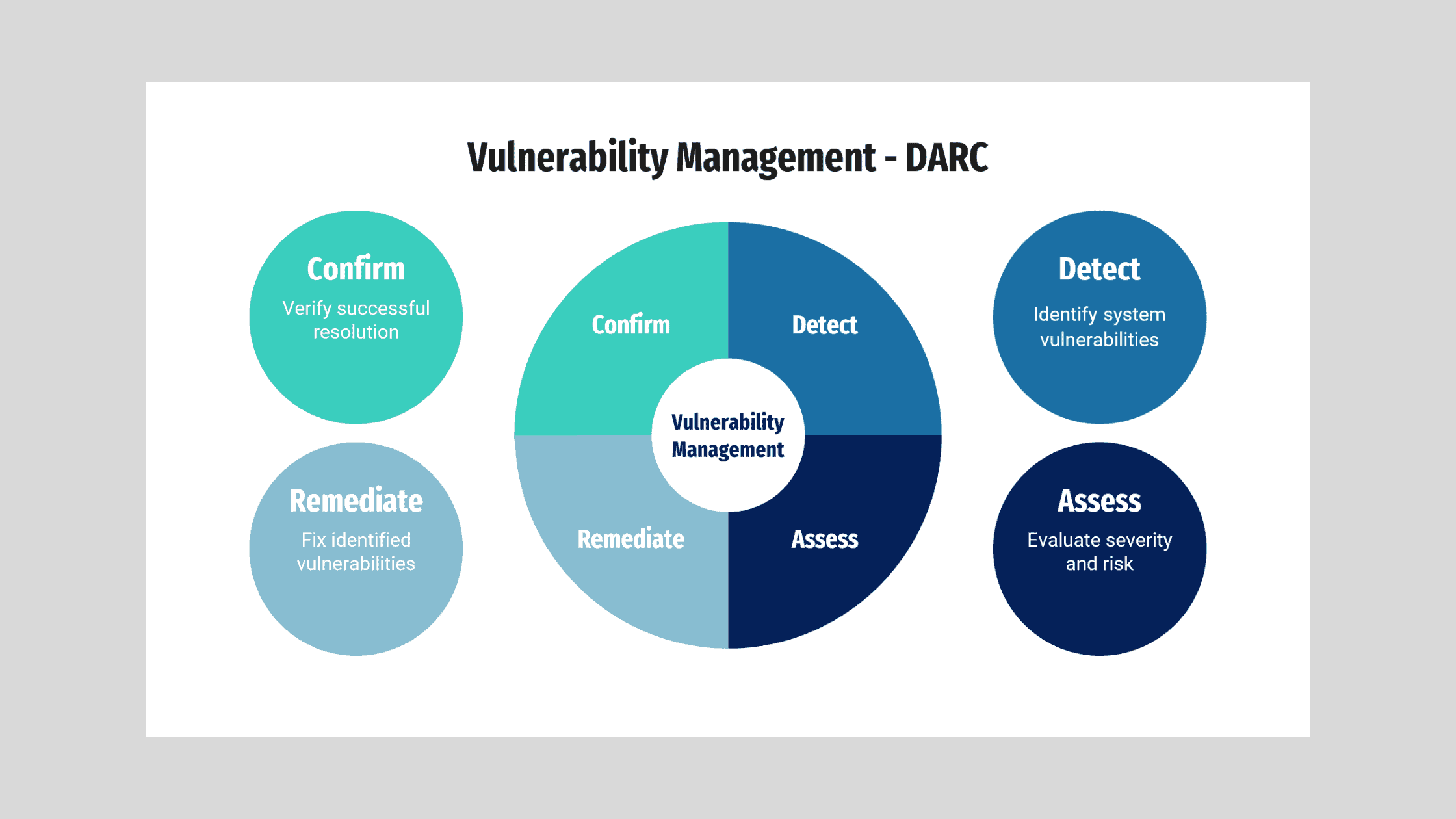BUSINESS
Strengthening Cybersecurity Posture with Advanced Vulnerability Management Workflows

Table of Contents:
- Key Takeaways
- Understanding Vulnerability Management Workflows
- Identifying Vulnerabilities in Your Organization
- Prioritizing Vulnerabilities for Remediation
- The Remediation Process: Strategies and Best Practices
- Verification and Validation Post-Remediation
- Integrating Vulnerability Management into the Broader Security Strategy
- Future-Proofing: Adapting to Evolving Cyber Threats
- Best Tools and Resources for Vulnerability Management Workflow
- Legal and Regulatory Considerations in Vulnerability Management
- Conclusion: The Continuous Evolution of Vulnerability Management Workflows
Key Takeaways:
- Understanding the integral role of vulnerability management workflows in cybersecurity.
- Techniques for effective identification, prioritization, and remediation of vulnerabilities.
- Strategies for integrating vulnerability management within a comprehensive security program.
- Staying updated with evolving cyber threats is important to maintaining robust security protocols.
Understanding Vulnerability Management Workflows
An integrated security workflow encompasses a systematic approach to identifying, classifying, prioritizing, and addressing vulnerabilities within an organization’s technology environment. Implementing such methods is crucial to thwarting potential breaches and safeguarding digital information. A thorough vulnerability management plan lays out explicit steps to neutralize threats before they translate into actual harm. Workflows can vary from simple checklists to complex, automated processes involving a variety of cybersecurity tools.
Vulnerabilities come in many forms, ranging from software bugs to misconfigurations, all of which pose varying degrees of risk to the safety of organizational data. Thus, integrating a robust and repeatable process ensures both minor and critical vulnerabilities are addressed promptly.
Identifying Vulnerabilities in Your Organization
Crucial to the cybersecurity lifecycle is the ability to spot weaknesses before they can be exploited. To accurately identify these digital chinks in the armor, organizations deploy a multitude of tools—from static application security testing (SAST) to dynamic analysis (DAST) and beyond. By harnessing these technologies, it’s possible to obtain a holistic view of the organization’s security style, pinpointing exposure areas within applications, networks, and systems.
Beyond automated tools, manual tactics, including rigorous code reviews and penetration tests, provide additional layers of scrutiny. These assessments simulate hackers’ strategies, revealing potential entry points and markers for urgent revision. Regularly scheduled tests are fundamental, as they help unearth new threats that evolve as part of the changing cyber landscape, ensuring an organization’s protective measures are always current and effective.
Prioritizing Vulnerabilities for Remediation
After establishing a clear picture of existing vulnerabilities, the next critical step is determining which issues to tackle first. Not all security gaps exert the same level of threat to an organization’s infrastructure. Some vulnerabilities may grant attackers direct access to sensitive systems, while others might only have a peripheral impact. Factors that influence the prioritization of remediation efforts include the potential for data loss, system downtime, or the exploitation of critical infrastructure.
Effectively prioritizing vulnerabilities entails a comprehensive risk assessment, considering the likelihood of a security gap being exploited and the potential damage that could result. It’s a delicate balancing act that weighs the flaw’s severity against the resources available to address it—ensuring that the most critical weaknesses receive immediate attention. In contrast, others are scheduled for future remediation.
The Remediation Process: Strategies and Best Practices
Once vulnerabilities have been categorized and prioritized, the next phase is remediation. This process entails developing and deploying fixes to the identified issues through software patches, system updates, or alterations in network configurations. One of the best practices in remediation is maintaining a patch management policy, ensuring all software is up-to-date and resistant to known threats.
However, this journey from detection to remediation is often fraught with challenges. It’s critical to balance the speed of response with the necessity for accuracy in deploying fixes. Quick fixes may inadvertently introduce new vulnerabilities if not thoroughly tested. Sharing experiences of successful vulnerability resolution can provide useful insights for organizations looking to refine their remediation strategies.
Verification and Validation Post-Remediation
Remediating a vulnerability is not the endpoint of the management workflow; it’s critical to have mechanisms to verify and validate that the measures taken have effectively addressed the security gap. This often involves re-scanning the environment, conducting post-remediation penetration tests, or evaluating system logs for unusual activity that might indicate a lingering issue.
Continuous verification integrates assessment processes within routine operations, creating an environment where security becomes an ongoing concern rather than an afterthought. This ensures that fixes are deployed and remain effective over time, adjusting as needed to the changing threat landscape and organizational practices.
Integrating Vulnerability Management into the Broader Security Strategy
Vulnerability management can only stand with an organization’s aims for a truly resilient cybersecurity defense. It must be part of an integrated security strategy encompassing other components, such as endpoint protection, firewall deployment, and employee security awareness training. When each element works in concert, the organization’s security posture becomes more than the sum of its parts—forming a robust and responsive shield against cyber threats.
Furthermore, fostering a sense of shared responsibility for cybersecurity amongst staff members can go a long way. Through regular training and fostering a culture that values security, organizations can ensure that every layer of their defense—from the technology to the personnel—is optimized to detect and deter potential attacks.
Future-Proofing: Adapting to Evolving Cyber Threats
As attackers become more sophisticated, so must the defenses arrayed against them. Organizations must constantly refine their vulnerability management workflows for the latest security threats. Leveraging emerging technologies, like machine learning and artificial intelligence, can provide predictive capabilities to anticipate threats before they materialize.
Moreover, staying abreast of trends and emerging threats is not simply about purchasing the latest technologies; it also involves tapping into the collective wisdom of the cybersecurity community through forums, threat intelligence sharing, and industry-wide research compendiums. Organizations can ensure they are prepared to meet the challenges of tomorrow’s threat landscape head-on by continuously evolving and adapting security workflows.
Best Tools and Resources for Vulnerability Management Workflow
Investing in the right set of tools is critical for executing an effective vulnerability management workflow. Selections should be made based on compatibility, scalability, and the ability to integrate with other security platforms. Security solutions that offer comprehensive visibility, along with automated alerting and reporting capabilities, are often at the forefront of the industry.
Communities play a key role in staying informed and responsive. Online forums provide platforms for information sharing and discussion. At the same time, security research projects contribute valuable insights into new vulnerabilities and defensive techniques. Understanding the tools and resources at one’s disposal is pivotal to formulating a resilient security strategy.
Legal and Regulatory Considerations in Vulnerability Management
The cyber domain is not only about technical prowess; a complex web of legal and regulatory frameworks also governs it. These rules shape how organizations manage data security, privacy, and breaches. Complying with regulations such as the General Data Protection Regulation (GDPR) or the Health Insurance Portability and Accountability Act (HIPAA) is imperative for businesses operating internationally or handling sensitive personal data.
Navigating these waters requires diligence and often the assistance of legal experts who specialize in cybersecurity law. Ignoring these aspects can lead to severe penalties and damage an organization’s reputation.
Conclusion: The Continuous Evolution of Vulnerability Management Workflows
In conclusion, the realm of cybersecurity is a battlefield in continuous flux. Advanced vulnerability management workflows provide the strategies necessary to manage and anticipate the maneuvers of would-be attackers. As organizations embrace these comprehensive approaches, integrating cutting-edge tools and heeding regulatory requirements, they construct more reliable and robust systems capable of withstanding the onslaught of evolving threats. By accepting that the process of vulnerability management is never complete but a perpetual cycle of improvement, entities can forge ahead with confidence, knowing they are well-prepared to meet and mitigate future cyber challenges.
BUSINESS
Unleashing the Power of Information: A Deep Dive into https: //ontpress.com

Welcome to the digital age, where information reigns supreme and access to knowledge is key. In a world driven by data, staying informed has never been more crucial. Imagine a platform that serves as your gateway to a wealth of valuable insights and resources – enter OntPress! Get ready to dive into the boundless ocean of information with us as we explore how https://ontpress.com is revolutionizing the way we interact with knowledge.
The Importance of Information in Today’s World
In today’s fast-paced digital age, information is more valuable than ever before. It serves as the foundation for decision-making, innovation, and progress. The ability to access accurate and timely information can make or break businesses, influence global events, and empower individuals.
Information shapes our understanding of the world around us. It provides insights into trends, opportunities, and challenges that impact various aspects of society. With the vast amount of data available at our fingertips, staying informed has become a crucial skill in navigating an increasingly complex landscape.
Businesses rely on information to stay competitive and relevant in their industries. By leveraging data-driven insights, companies can make strategic decisions that drive growth and profitability. From market research to customer feedback, information fuels every aspect of modern business operations.
In essence, information is not just about facts and figures; it’s about empowering individuals with knowledge that can transform lives and shape the future.
Features and Services Offered by OntPress
OntPress offers a wide array of features and services designed to empower users with valuable information at their fingertips. One notable feature is its user-friendly interface, making it easy for anyone to navigate and access the wealth of knowledge available on the platform.
Additionally, OntPress provides personalized recommendations based on user preferences, ensuring that each individual receives tailored content that meets their specific needs and interests. This customization enhances the overall user experience and encourages continued engagement with the platform.
Moreover, OntPress boasts a vast library of articles, research papers, and publications across various industries and topics. Whether you’re seeking business insights, academic resources, or lifestyle tips, OntPress has got you covered.
Furthermore, OntPress offers advanced search functionalities that allow users to quickly find relevant information without hassle. With just a few clicks, users can discover new trends, explore in-depth analyses, and stay up-to-date on the latest developments in their field of interest.
Success Stories of Businesses Utilizing OntPress
Picture this: businesses across various industries leveraging OntPress to unlock their full potential. From small startups to established corporations, the power of information is propelling them forward like never before. Take Company X, for example. By harnessing OntPress’s cutting-edge features and services, they were able to streamline their operations, enhance decision-making processes, and ultimately boost their bottom line.
Then there’s Company Y, a tech firm that utilized OntPress to stay ahead of the curve in an ever-evolving market. With access to real-time data and insights at their fingertips, they were able to pivot quickly and adapt to changing trends with ease. And let’s not forget about Company Z, a retail giant that transformed its customer experience by personalizing interactions through the valuable information provided by OntPress.
These success stories are just a glimpse into how businesses are thriving in today’s fast-paced digital landscape thanks to OntPress.
How OntPress is Revolutionizing the Way We Access Information
In today’s fast-paced digital age, access to information is key. OntPress is at the forefront of revolutionizing the way we gather and consume knowledge. With its user-friendly interface and vast database, OntPress provides a one-stop platform for all your informational needs.
Gone are the days of tirelessly scouring through multiple sources – OntPress streamlines this process by offering curated content tailored to your interests. Whether you’re a student conducting research or a professional seeking industry insights, OntPress has you covered.
By leveraging cutting-edge technology and expert curation, OntPress ensures that users have access to accurate and up-to-date information at their fingertips. Say goodbye to outdated encyclopedias – with OntPress, knowledge is always evolving and readily available.
Join the movement towards seamless information access with OntPress – where learning meets innovation in the digital realm.
The Future of OntPress and Its Impact on Society
The future of OntPress holds immense potential to shape society in profound ways. With its innovative approach to information sharing and accessibility, OntPress is poised to revolutionize the way we interact with data. As technology advances and the demand for instant knowledge grows, OntPress is at the forefront of providing a solution that caters to these evolving needs.
By offering a platform that prioritizes user experience and seamless navigation, OntPress is bridging the gap between individuals and valuable information. This not only empowers users to make informed decisions but also fosters a culture of continuous learning and growth within communities.
As OntPress continues to expand its reach and enhance its services, the impact on society will be far-reaching. From enabling businesses to make data-driven decisions to empowering individuals with knowledge at their fingertips, OntPress is paving the way for a more connected and informed world.
The possibilities are endless as OntPress propels us towards a future where information is not just accessible but transformative in shaping our collective understanding of the world around us.
Conclusion: Why You Should Join the OntPress Community
Why You Should Join the OntPress Community
As we have explored in this article, OntPress is not just a platform; it is a gateway to a world where information empowers businesses and individuals alike. By joining the OntPress community, you gain access to a wealth of knowledge and resources that can transform the way you work, learn, and stay informed.
With its mission to democratize information and make it accessible to all, OntPress is paving the way for a future where knowledge truly is power. Whether you are an entrepreneur looking to grow your business or an individual seeking valuable insights, OntPress has something for everyone.
Joining the OntPress community means becoming part of a network that values transparency, collaboration, and innovation. It’s about connecting with like-minded individuals who share your passion for learning and discovery. So why wait? Embrace the power of information today by joining OntPress – where knowledge knows no bounds.
BUSINESS
The Ultimate Guide to AWM99X: How It Can Revolutionize Your Business

Are you ready to take your business to the next level? Imagine a powerful tool that can revolutionize the way you operate, streamline processes, and boost efficiency. Enter AWM99X – the game-changer that is transforming businesses worldwide. In this ultimate guide, we will delve into what AWM99X is all about, its benefits, key features, real-life success stories, and how you can seamlessly integrate it into your business strategy. Get ready to unlock a world of possibilities with AWM99X!
What is AWM99X and how does it work?
Have you heard of AWM99X and wondered how it can revolutionize your business? Let’s delve into what this cutting-edge technology is all about. AWM99X is an innovative software solution designed to streamline operations, enhance efficiency, and drive growth for businesses across various industries.
So, how does AWM99X work its magic? This powerful platform leverages advanced algorithms and data analytics to provide real-time insights, automate processes, and optimize decision-making. By harnessing the power of artificial intelligence and machine learning, AWM99X enables businesses to uncover hidden patterns in their data, predict future trends, and make informed strategic choices.
With AWM99X at your fingertips, you can say goodbye to manual tasks and hello to a more agile and competitive business environment. Whether you’re looking to improve customer engagement, boost productivity, or maximize profits – AWM99X has got you covered. Stay ahead of the curve with this game-changing technology!
Benefits of using AWM99X for your business
Are you looking to take your business to the next level? AWM99X could be the game-changer you’ve been searching for. With AWM99X, you can streamline your operations, improve efficiency, and boost productivity like never before.
One of the key benefits of using AWM99X is its ability to automate repetitive tasks. Say goodbye to manual data entry and mundane processes – let AWM99X handle them for you while you focus on more strategic initiatives.
Moreover, AWM99X provides real-time analytics and insights that can help drive informed decision-making. By having access to accurate data at your fingertips, you can make smarter choices that positively impact your bottom line.
Additionally, with AWM99X’s customizable features and tools, you can tailor the platform to suit your specific business needs. Whether it’s inventory management or customer relationship management, AWM99X has got you covered.
In a competitive business landscape where agility is key, leveraging AWM99X can give you the edge needed to stay ahead of the curve.
Case studies of successful businesses using AWM99X
Have you ever wondered how successful businesses are leveraging AWM99X to streamline their operations and drive growth? Let’s dive into some intriguing case studies that showcase the transformative power of this cutting-edge technology.
In a recent study, Company XYZ, a leading e-commerce retailer, implemented AWM99X to optimize their inventory management. By harnessing real-time data insights and automated processes, they were able to reduce stockouts by 30% and increase sales by 20% within just three months.
Another compelling example is Business ABC, a global logistics provider. By integrating AWM99X into their supply chain systems, they achieved remarkable cost savings through route optimization and enhanced shipment tracking capabilities. This led to improved customer satisfaction rates and strengthened partnerships with key clients.
These success stories highlight the versatility and effectiveness of AWM99X across various industries. Stay tuned for more inspiring case studies that illustrate the game-changing potential of this innovative solution.
Key features and tools offered by AWM99X
Are you ready to take your business to the next level? Look no further than AWM99X, a cutting-edge tool designed to streamline your operations and boost efficiency. With a user-friendly interface, AWM99X offers a range of key features and tools that can revolutionize the way you do business.
One standout feature is its advanced analytics dashboard, providing real-time insights into crucial metrics like sales performance and customer behavior. Say goodbye to guesswork – with AWM99X, data-driven decision-making becomes effortless.
In addition, AWM 99X boasts seamless integration capabilities with popular CRM systems and e-commerce platforms. This means you can centralize your processes and eliminate silos for enhanced collaboration across departments.
Furthermore, the automation tools offered by AWM 99X allow you to optimize workflows and reduce manual tasks. Spend less time on repetitive work and more time focusing on strategic initiatives that drive growth.
Incorporating AWM 99X into your business strategy is not just an option – it’s a necessity in today’s competitive landscape. Stay ahead of the curve with this powerful tool at your fingertips.
How to integrate AWM99X into your current business strategy
Looking to take your business strategy to the next level? Integrating AWM 99X could be just what you need. The first step is understanding your current processes and where AWM 99X can fit in seamlessly.
Start by identifying areas within your operations that could benefit from automation, such as repetitive tasks or data analysis. Once you pinpoint these areas, map out how AWM 99X can streamline these processes and improve efficiency.
Collaborate with key stakeholders in your organization to get their buy-in and support for integrating AWM 99X. Training sessions may be necessary to ensure all team members are comfortable using the new tools effectively.
Monitor the implementation closely and gather feedback from employees on how AWM 99X is impacting their workflow. Adjustments may be needed along the way to optimize its performance within your business strategy.
By strategically integrating AWM 99X into your current operations, you’re setting yourself up for greater productivity and success in the long run.
Potential challenges and how to overcome them when implementing AWM99X
Implementing AWM 99X into your business strategy can come with its own set of challenges. One common obstacle is the resistance to change from employees who are comfortable with existing processes. To overcome this, it’s crucial to communicate the benefits of AWM99X clearly and involve staff in the transition process.
Another challenge could be integrating AWM 99X seamlessly with your current systems and workflows. This may require time and resources for training and customization. Working closely with the AWM 99X provider for support during this phase can help streamline the integration process.
Data security concerns may also arise when adopting a new technology like AWM 99X. Implementing robust security measures, conducting regular audits, and providing training on data protection best practices can mitigate these risks effectively.
Maintaining momentum and ensuring ongoing user adoption post-implementation can be challenging. Regular monitoring, feedback collection, and continuous improvement efforts will be essential to sustain success in leveraging AWM99X for your business growth.
The future of AWM99X
As we look ahead to the future of AWM99X, the possibilities seem endless. With continuous advancements in technology and data analytics, AWM 99X is poised to revolutionize businesses across industries. From enhanced customer experiences to streamlined operations, this cutting-edge solution will continue to drive innovation and growth.
Embracing AWM99X as a key component of your business strategy can pave the way for sustained success in a rapidly evolving market landscape. By leveraging its powerful features and tools, businesses can stay ahead of the curve and unlock new opportunities for growth and profitability.
Incorporating AWM 99X into your operations may present challenges along the way, but with careful planning, effective communication, and proper training, these obstacles can be overcome. The key lies in embracing change, adapting to new technologies, and continuously seeking ways to optimize processes for maximum efficiency.
As we navigate through an era defined by digital transformation and technological disruption, AWM 99X stands out as a game-changer that has the potential to reshape businesses for years to come. Stay tuned for what lies ahead as AWM 99X continues to shape the future of business innovation.
BUSINESS
How AWS Consulting Can Optimize Your Business Operations
Key Takeaways:
- AWS consulting provides tailored solutions that align with your business goals.
- Automation through AWS services enhances operational efficiency and reduces manual interventions.
- Cost optimization strategies help reduce cloud expenditures and improve resource allocation.
- Scalable AWS solutions adapt to changing business needs, ensuring seamless growth.
- Security and compliance measures protect your data and applications, building customer trust.
Table of Contents:
- Introduction
- Benefits of AWS Consulting
- Enhancing Efficiency Through Automation
- Cost Optimization Strategies
- Scalability and Flexibility
- Improving Security and Compliance
- Conclusion
Introduction
Companies must continuously evolve to stay competitive in today’s fast-paced business environment. One way to achieve this evolution is by leveraging the potential of cloud computing. Amazon Web Services (AWS) offers a comprehensive suite of cloud services that can transform business operations. However, maximizing the benefits of AWS requires specialized knowledge and expertise. This is where AWS consulting comes into play. AWS consultants provide valuable guidance and technical support to help businesses optimize their cloud infrastructure, enhance efficiency, and reduce costs. By partnering with AWS experts, companies can navigate the complexities of cloud computing, making it easier to innovate and scale their operations. Moreover, consultants bring a wealth of experience and can provide insights that might be absent to in-house teams, thus significantly accelerating the implementation and optimization processes.
Benefits of AWS Consulting
Working with AWS consultants offers several advantages that go beyond basic implementation. First and foremost, AWS consulting provides tailored solutions that align with your business goals. Consultants take the time to understand your unique needs and challenges, ensuring that AWS services are customized to deliver maximum value. Additionally, AWS consultants can thoroughly analyze your existing infrastructure to identify areas for improvement. This proactive approach allows businesses to leverage AWS services to their fullest potential, increasing efficiency and competitive advantage. Moreover, AWS consulting guarantees that your company stays current with the most recent cloud technologies and optimal methods. This continuous improvement keeps you ahead of the curve in a rapidly evolving digital landscape.
Enhancing Efficiency Through Automation
One of the primary ways AWS consulting can optimize business operations is by introducing automation. AWS offers a variety of tools and services designed to simplify everyday tasks, allowing your team to concentrate on important strategic projects. One example is AWS giving you the ability to execute code when events occur, without the need to set up or oversee servers. This serverless computing model can significantly improve operational efficiency by reducing manual interventions and minimizing downtime. Moreover, AWS Step Functions enable you to coordinate multiple AWS services into serverless workflows, automating complex business processes. By leveraging these automation tools, businesses can achieve higher levels of productivity and accuracy, ultimately leading to better outcomes. Automation streamlines operations, reduces errors, and enhances overall quality, benefiting service-oriented industries.
Cost Optimization Strategies
Cost optimization is another critical area in which AWS consulting can substantially impact. Efficient cost control is necessary to optimize the ROI from cloud services. AWS consultants help you analyze your current spending patterns and identify opportunities for savings. For instance, they can recommend suitable pricing models, such as reserved or spot instances, to reduce costs.
Additionally, AWS consultants can implement cost management tools that provide real-time insights into your cloud expenditures. These tools enable tracking usage, establishing budgets, and getting notifications for abnormal spending patterns. Businesses can prevent unnecessary costs and allocate resources more effectively by proactively managing expenses. This detailed analysis and strategic cost management can ensure long-term financial health and sustainability, which is crucial for companies aiming for long-lasting growth.
Scalability and Flexibility
AWS consulting also enables businesses to scale their operations seamlessly. AWS offers a range of scalable solutions that can adapt to your changing needs. Whether you’re experiencing a sudden surge in demand or need to expand to new markets, AWS ensures that your infrastructure can keep up. AWS consulting helps you design a scalable, flexible, and robust architecture, allowing your business to grow without facing technological constraints. This level of scalability ensures that your applications perform optimally, even during peak usage times. Moreover, flexible cloud architectures can support a variety of business models and applications, making it easier for companies to introduce new products or services without requiring extensive reconfiguration of their existing systems.
Improving Security and Compliance
Security and compliance are paramount in today’s digital landscape. AWS consulting helps businesses implement stringent security measures to protect their data and applications. AWS provides comprehensive security tools, including identity and access management, encryption, and threat detection. Businesses that adopt cloud security measures witness a significant reduction in data breaches. AWS consultants guide you through setting up these tools and ensuring your infrastructure complies with relevant regulations. They can also assist with conducting regular security audits and implementing best practices to mitigate risks. By prioritizing security and compliance, businesses can safeguard their assets and build trust with their customers. Compliance with industry standards and regulations protects data and enhances a company’s reputation and reliability, which is vital for maintaining customer loyalty and business integrity.
Conclusion
AWS consulting offers many benefits that can significantly optimize your business operations. From enhancing efficiency through automation to implementing cost optimization strategies and improving security, AWS consultants provide invaluable support to help you navigate the complexities of cloud computing. By partnering with AWS experts, you can ensure that your organization leverages the full potential of AWS services, driving growth and innovation in the process. Whether you are a startup looking to scale quickly or an established enterprise aiming to modernize your infrastructure, AWS consulting can help you achieve your goals more effectively. The dynamic nature of AWS solutions, combined with expert consulting, allows businesses to meet their current needs and future-proof their operations against upcoming technological trends and market demands.
-

 LOVE MESSAGES7 months ago
LOVE MESSAGES7 months agoSweet Love Messages for Her to Make Her Smile
-

 LOVE MESSAGES7 months ago
LOVE MESSAGES7 months ago100 Romantic Good Evening Messages For Her & Him
-

 LOVE MESSAGES7 months ago
LOVE MESSAGES7 months agoRomantic Love Messages For My Husband With Images
-

 LOVE MESSAGES7 months ago
LOVE MESSAGES7 months ago50 Just Checking on You Text Messages for Him & Her
-

 LOVE MESSAGES7 months ago
LOVE MESSAGES7 months agoSweet Love Messages For My Wife With Images
-

 LOVE MESSAGES7 months ago
LOVE MESSAGES7 months ago50 Cute Good Night Sweet Dreams Messages For Lovers
-

 LOVE MESSAGES7 months ago
LOVE MESSAGES7 months ago25 Romantic I Love You Messages for Her
-

 LOVE MESSAGES7 months ago
LOVE MESSAGES7 months agoLong Good Morning Messages to Make Her Fall in Love










